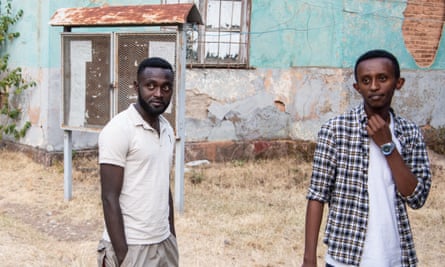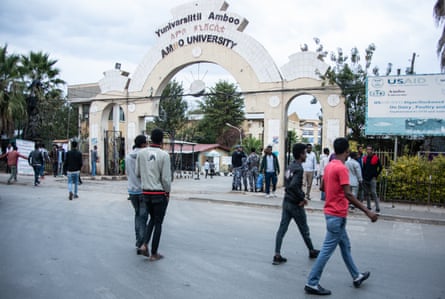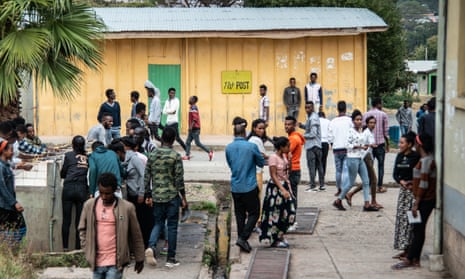On a December morning last year, students at Ambo University in Ethiopia’s Oromia region awoke to find threatening notices pinned to the walls of their dormitories. The message was simple: boycott classes. Anyone failing to do so would face punishment.
Written by Oromo student activists calling themselves the Qeerroo, the notices demanded solidarity with fellow Oromos at universities in the neighbouring region of Amhara, after a spate of deadly ethnic clashes there. Similar boycotts had been called in universities across Oromia, the country’s largest region.
Ethiopia’s most recent round of campus unrest began in November, when fighting broke out at Woldia University in Amhara between students watching a football match on television. One student was thrown off a building to his death, another was beaten to death, 13 were injured. The violence spread to universities across both regions.
A few days later, an Amhara student allegedly died at the Oromia university of Dembi Dollo. By February at least 12 students had been killed in clashes in 22 of Ethiopia’s 45 public universities, mostly between Amharas and Oromos, who together make up about two-thirds of the country’s population of 100 million. Most recently, on 4 March, a third student was allegedly killed at Amhara’s Wollo University, after a fight broke out in the pool house.
In Ambo, no one died. But bouts of violence in November, involving stones and knives, caused many injuries and prompted nearly a thousand, mostly male students from Amhara to flee by bus for their own safety. Classes and exams were postponed for several weeks.
Similar exoduses of both Amhara and Oromo students took place across the country, and by mid-January an estimated 35,000 students had quit class as a result of the unrest. Before the outbreak of Covid-19 this month forced universities to suspend classes once more, many had returned – though some had asked to be transferred to their home region, or enrolled in private colleges instead. To maintain order, the government has effectively imposed a state-of-emergency conditions at all public universities, deploying federal police, enforcing curfews and banning unauthorised gatherings.

“It is very difficult to say for sure that things are calm now,” said Eyob Gashu, an Amhara student who fled Ambo University after witnessing clashes on campus, but returned a month later to take his exams. “Without the police here there would be no teaching or learning at all. There is suspicion and fear still.”
Ethiopia’s campus wars have a long history. Ever since the late 60s, when what was then the sole university, Haile Selassie I (now Addis Ababa University), became a hotbed of anti-government activity, student unrest has had an ethnic and sometimes violent edge. In 1967, for instance, there was a riot at the faculty of education between Tigrayan and Amhara students that went on for several days. Serious ethnic clashes took place at Bahir Dar polytechnic two years later.
But they are becoming more frequent and more deadly. A report by the Centre for Advancement of Rights and Democracy (Card), a local NGO, documented at least nine rounds of university-based conflict since December 2017, many flaring up on more than one campus at a time.
The unrest is partly the result of Ethiopia’s distinct model of ethnically-based federalism, established in 1994, which has ensured the recognition of minority groups but also hardened ethnic identities. In the past two years alone, about 3 million Ethiopians have been displaced and hundreds killed in waves of ethnic and regional violence.
Troubles on campus are also in part a consequence of failings in the federal system. Universities, as federal institutions with mixed populations, are much more diverse places than most schools and workplaces. But they have grown increasingly homogenous in recent years, following a shift away from the old pattern of posting students and academics to universities far from their home region.
Today, each university is the de facto property of an ethnic group, according to Yonas Ashine, author of the Card report. Most staff and management are locals, and the leadership of student unions is drawn mostly from the indigenous ethnicity. This can aggravate tensions between students.

“The whole idea of establishing campuses all over the country was to bring federal institutions closer to the people, to promote national cohesion,” said Zemelak Ayele of Addis Ababa University’s centre for federal studies. “But over time all universities have become more and more ethnically homogeneous. That is where the problem is.”
Card’s director, Bekefadu Haile, said: “The ethnicisation of administrations is itself a factor. Almost all heads, deans and presidents are from the same ethnic group, so you don’t even have a place to complain about your marginalisation.”
Language also undermines cohesion. According to national law, all universities are expected to teach in “neutral” English, but many lecturers are not fluent. In universities in Oromia, in particular, teaching is often in the local language – one consequence of the failure of the federal system to promote a common tongue.
Amara Mitiko, an economics lecturer at Wollo University, was initially sent to Wollega University in western Oromia after graduating. “The whole campus spoke only Afaan Oromo – few people spoke English,” he said. “So they couldn’t understand me and I couldn’t understand them.”
Campus life is hyper-politicised. Political parties have close links to universities, with many lecturers doubling as party members. Two of the leaders of the Oromo Federalist Congress, one of the main opposition parties, are employed at Addis Ababa University. Two of the founders of the radical ethno-nationalist National Movement of Amhara are staff in Wollo University’s law department. Many influential political activists on social media are students.

“Students are seen as political players,” said Likke Serawitu, a freshman at Ambo University. “Right back to the imperial era in the 1960s, students have been seen as catalysts for change.”
Ethiopian politics is increasingly dominated by competition between the two largest ethnic groups, Amhara and Oromo. “These conflicts on campus are just a reflection of political rivalries between two ethno-nationalist groups: Amhara and Oromo,” said Zelalem Eshetu, a law lecturer and university attorney at Wollo. “They use the campus as an instrument to exert pressure on the government.”
The government has responded by beefing up security and tightening control over students. Disciplinary measures have been taken against 640 students and 40 teachers, says the Ministry of Higher Education.
This academic year, students, their parents and local officials, must sign draconian release forms for them to enrol at public universities. CCTV cameras are to be installed on all campuses and a new law to combat hate speech and fake news gives authorities power to censor political activists on social media, who wield enormous influence in universities.
In January, the Minister of Higher Education suggested that free tuition was partly to blame for conflicts because it made it harder for universities to maintain the quality of education and housing for the roughly 200,000 new students enrolling each year. In 2000, Ethiopia had just two universities; now there are 45. It is one of the fastest expansions in higher education in the world, but without a concomitant rise in standards.

The government is now looking at alternative funding models, including student loans. “There should be some kind of co-financing from the private sector,” said Tassew Woldehanna, president of Addis Ababa University. “Students need to start paying.”
But Tekalign Nega, a lecturer at Addis Ababa University’s business college and co-founder of the Neighbour-Love Movement, a private initiative working to mend relations on campuses, says that the perceptions students have of each other need to be challenged.
“We need to tackle this tendency of ‘othering’ we have observed in Ethiopia in recent years – the tendency to view anyone who thinks differently from you as essentially less human,” he said. “Otherwise I don’t think there is any way forward.”
